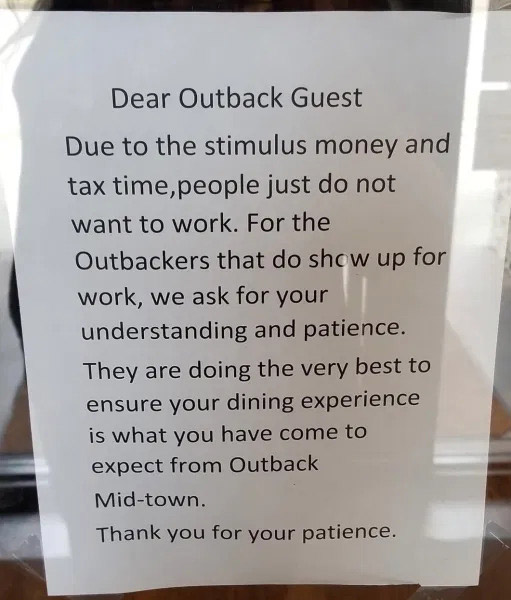
Featured Image: iStock/oatawa
The coronavirus pandemic has exposed a lot about the current economy. One of the startling discoveries made has been about the rate of employee turnover. The numbers have indicated that even in these uncertain economic times people have been quitting their jobs left, right, and center.
According to the Bureau of Labor Statistics, by August 2020, 2.8 million people had voluntarily left work.
If you are a business and you feel shocked by this, you are in for even more surprises. When the government eased down pandemic restrictions earlier this year and the restaurants started opening up, a huge chunk of the wait staff and other restaurant workers refused to return to work.
The workers and experts, both, cite low wages as the primary reason for this new development that has left quite a few restaurant owners in rage.

Image Source: Restaurant Manifesto
Currently, the nationwide employee turnover rate is a startling 57.3%. The turnover rate is the percentage of employees who leave their jobs over a certain period of time. The turnover rate still so high, businesses need to spot gaps in their employee retention and employee engagement programs and figure out how they can improve things.
To learn this, we first need to find out where things are going wrong.
According to the U.S. Mercer Turnover Survey, the top 5 reasons for why employees leave their jobs include:
Some other common reasons include:
As you can see, there are several reasons of various kinds regarding why employees look for new jobs. Some of these reasons are beyond your control – relocation or a career change, for example. Most of the other ones, however, you can foresee and prevent.
If you are an employer who considers the job market a buyer’s bonanza, consider the high costs associated with replacing experienced employees, hiring new ones, and training the new recruits.
Let’s talk more about this.
Market research indicates that turnover, though a common business occurrence puts huge dents into a business’ bottom line. There are direct and indirect costs associated with it. According to HR experts, the average cost of losing an employee, hiring a new one, and training them costs the business over $4,000.
Even hourly employees earning as low as $8/hour end up costing the business around $3,500 in turnover costs.
But this cost crosses normal thresholds when it comes to replacing highly-trained employees who are experienced and have hands-on knowledge. According to studies, the real cost of employee turnover is more than 200% of a highly-trained employee’s annual salary to replace them and hire and train a new one.
Employee retention plays a huge role in a business’ profits, its ability to attract the best skills, and its potential to outgrow its competitors.
On the other hand, if you have a high turnover rate at your company, it’s nearly impossible to maintain the momentum of growth. Instead, all the energies and resources are spent on hiring and training.
For a business that is able to keep its employees within its workforce, happy and engaged, the benefits are immense.
With a high turnover costing businesses so negatively and employee retention translating into great business success, let’s look at some of the best practices that retain top talent.
Remote work was once considered the culture of freelancers. The corporate world was skeptical to even explore if such a work environment was sustainable. However, as the pandemic ensued, the only possibility to run the economy was through work-from-home arrangements.
It has now become the new norm of professional life.
According to statistics, companies that allow remote work arrangements experience a 25% lower employee turnover than companies that insist on an in-person workforce.
What does the culture have to do with retention?
Your company’s culture is its soul and character. It represents the company’s values, beliefs, and vision. You can see the company’s culture in how employees interact with each other, how management deals with difficult decisions, whether the employee communication is open and transparent, and the kind of traditions the company promotes.
By consciously hiring employees who match with your company’s culture, and improving your organization’s culture overall, you can attract and retain the best employees. Studies have shown that in cases of job switches where the salary was nearly the same, it was the company’s culture that was the deciding factor.
This one is a no-brainer. If an employee has no or little interest in the job, they may not just be performing poorly but maybe at a high risk of leaving your workforce.
Gallup conducted a survey to find out how employee engagement is relevant to employee retention. According to this survey 54% of employees who feel disengaged and unmotivated with their current jobs feel ready to switch jobs with even a 20% or less salary increase.
However, if the employee felt engaged and inspired at work, this number dropped to 37%.
If you want to improve things at your workplace and want to retain your workforce, get to the source of the problem. Talk to your employees, take their feedback, and find out what they feel lacking at their current jobs.
One easy way to do it is to circulate employee engagement surveys at your company using an automated survey taker. These surveys provide critical feedback in understanding your employees’ relationship with their jobs, and what will be the factors that will drive their job searches. To make these surveys accurate, it’s important to know what to ask your employees and what not to.
Here is a great video we recently did about 10 important questions you should be asking in your employee retention surveys.
Conducting exit interviews with people who are leaving is also a great idea. These soon-to-be-former employees will feel more open and willing to share their honest feedback.
Also, make your feedback efforts more regular. Communicate to your employees that you value their input and are serious about making changes in how the company manages its employees. When you are talking to them, ask them about the culture, the wages, the management, and their feelings about their future at the company.
Provide your employees with job security. When workers believe that they may not last at their job, their interest starts to wane and their job engagement levels drop. As a result, instead of improving their work performance, they start to look for other jobs.
To retain your trained workforce, make sure to let them know that you value their work. Pay attention to managers and supervisors to see if their interactions with the workers are contributing to an insecure work environment. Know, so you can take preventive and corrective measures.
Employee retention best practices also include providing a fun working environment where people feel motivated to show up at work every day and do their best. Regular awards and recognitions also motivate people. It tells them that what they are doing is being noticed, appreciated, and recorded for future considerations.
In a nutshell, if you want people to give their best for your business and not take their talent and expertise elsewhere, you’ve got to show them your appreciation.
It could be monetary (wages, bonuses), physical (better chairs, functioning printers), psychological (recognition, regular feedback), and emotional (a sense of ownership, great colleagues/managers).
Kelvin Stiles is a tech enthusiast and works as a marketing consultant at SurveyCrest – FREE online survey software and publishing tools for academic and business use. He is also an avid blogger and a comic book fanatic.